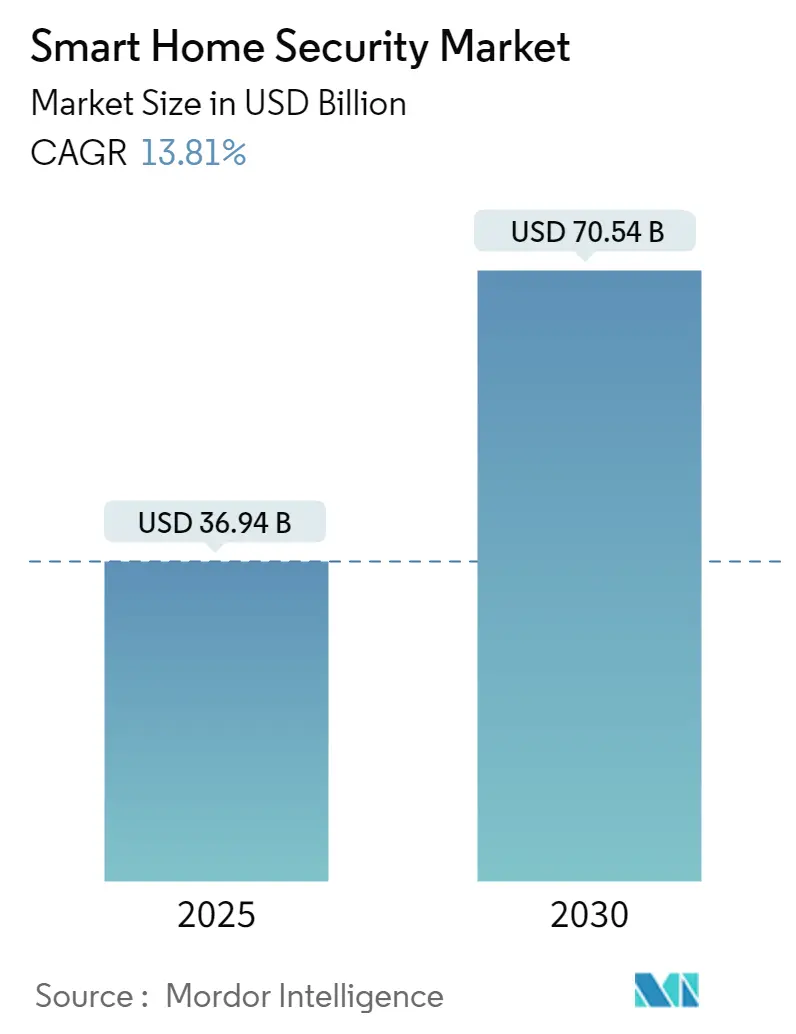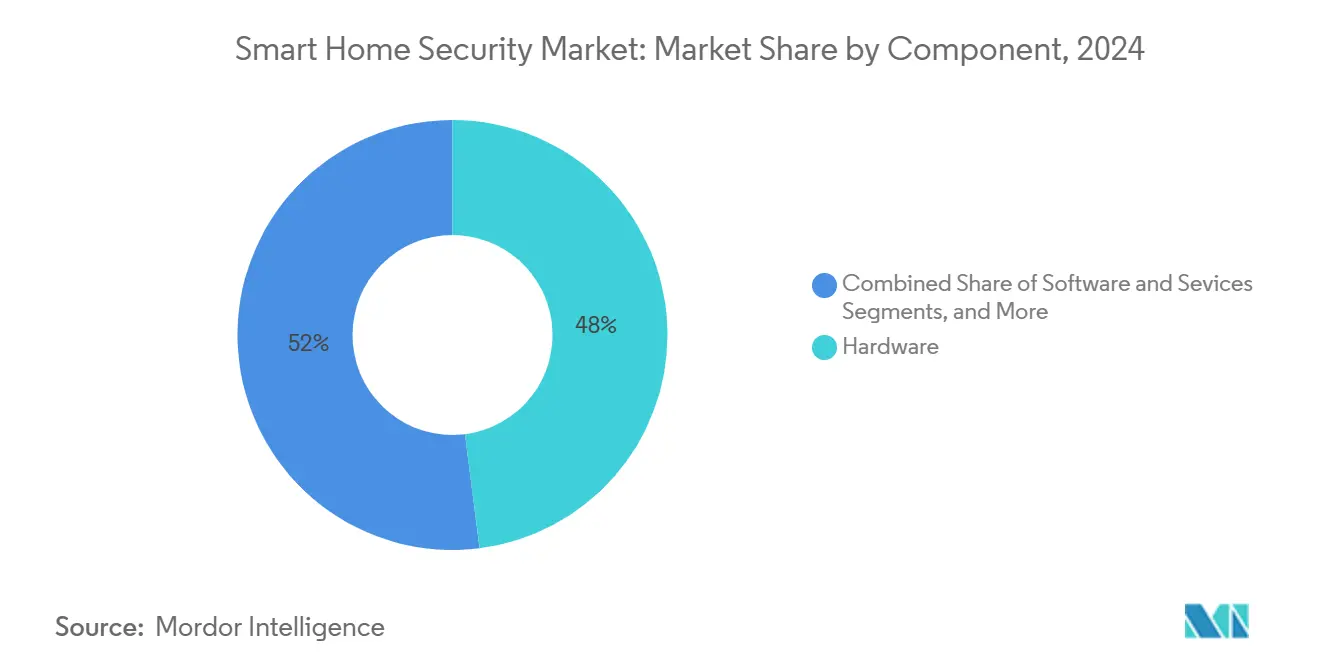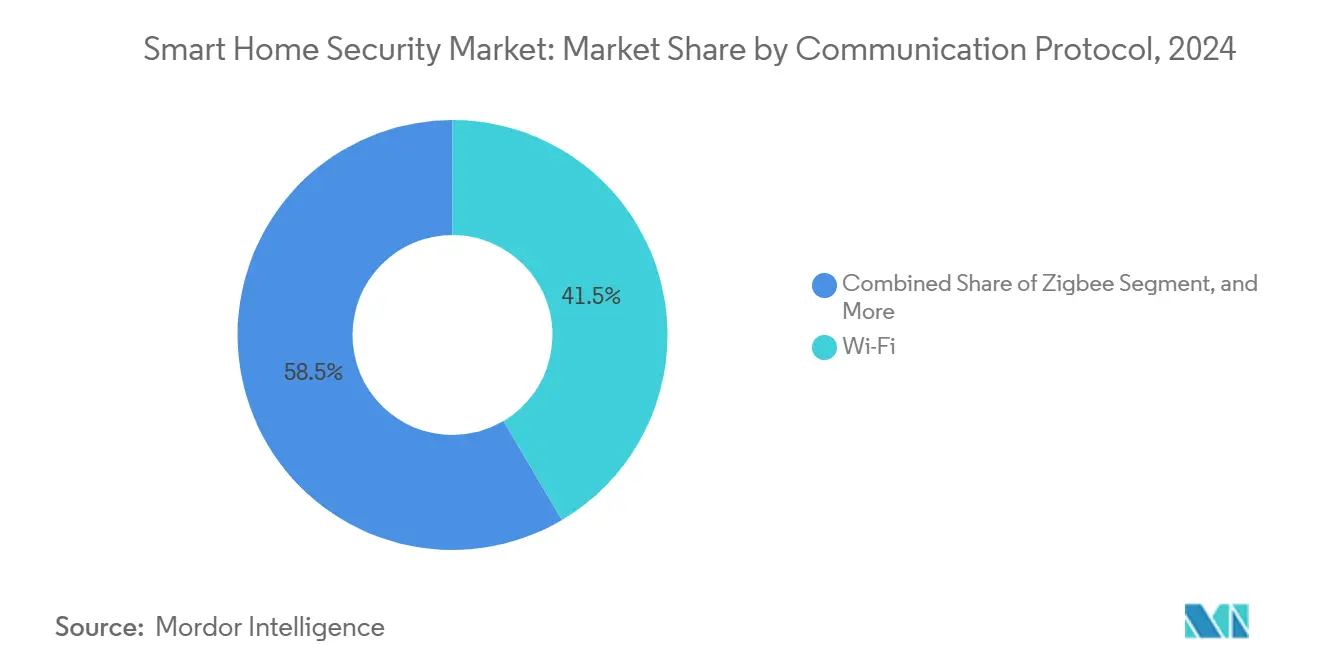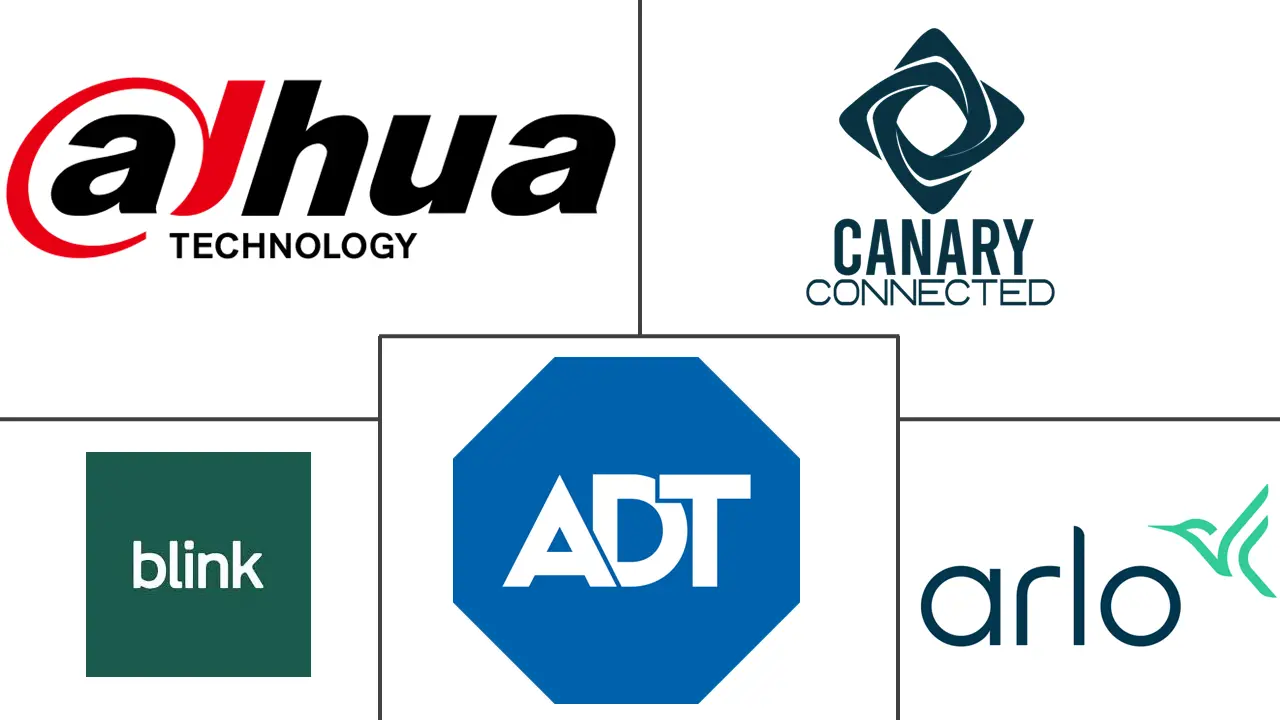Smart Home Security Market Size and Share

Smart Home Security Market Analysis by Mordor Intelligence
The Smart Home Security market size is poised to rise from USD 36.94 billion in 2025 to USD 70.54 billion by 2030 at a 13.81% CAGR. Growth accelerates as edge-based artificial intelligence trims false alarms, insurance carriers embed premium discounts for connected devices, and Matter-enabled interoperability reshapes product ecosystems. Device makers now bundle computer-vision analytics that learn household routines, while carriers such as Nationwide reward policyholders who adopt professionally monitored packages. Government trade-in incentives in China and 5G fixed-wireless deployments in North America further widen the addressable base. Competitive intensity remains moderate because leading brands strike a balance between subscription innovation and privacy compliance, yet cost pressures from spikes in rare-earth input and cyber-insurance surcharges temper margins. Together, these forces underpin a demand cycle that places integrated doorbell and lock cameras, along with cloud analytics, at the center of residential protection strategies.
Key Report Takeaways
- By component, hardware led the Smart Home Security market with a 48% share in 2024, while services are projected to expand at a 13.95% CAGR through 2030.
- By device type, smart cameras accounted for 52.3% of the Smart Home Security market size in 2024; combined doorbell and lock cameras are forecasted to advance at a 13.88% CAGR through 2030.
- By communication protocol, Wi-Fi protocols accounted for 41.5% of the revenue in 2024, whereas Thread-Matter devices are expected to grow at a 14.12% CAGR during the outlook period.
- By dwelling type, independent homes accounted for 46.2% of the revenue in 2024, but condominiums and MDUs are projected to log the fastest growth rate of 14.07% from 2024 to 2030.
- By geography, North America retained 62% of the revenue in 2024, while the Asia Pacific is on track for the strongest 14.40% CAGR through 2030.
Global Smart Home Security Market Trends and Insights
Drivers Impact Analysis
| Driver | % Impact on CAGR Forecast | Geographic Relevance | Impact Timeline |
|---|---|---|---|
| AI-enabled edge analytics cut false alarms | +2.1% | Global, with early adoption in North America and Europe | Medium term (2-4 years) |
| Insurance-linked device rebates spur installs | +1.8% | North America and Europe, expanding to Asia Pacific | Short term (≤ 2 years) |
| Matter/Thread interoperability lowers vendor lock-in | +1.5% | Global, led by North America and Europe | Medium term (2-4 years) |
| Crime-to-solution datasets accelerate predictive policing partnerships | +1.2% | North America and Europe, with selective Asia Pacific adoption | Long term (≥ 4 years) |
| Energy-aware security devices tap rising sustainability budgets | +0.9% | Europe and North America, emerging in Asia Pacific | Medium term (2-4 years) |
| 5G FWA roll-outs boost bandwidth for cloud-video plans | +1.4% | Global, with faster deployment in Asia Pacific and North America | Short term (≤ 2 years) |
| Source: Mordor Intelligence | |||
AI-Enabled Edge Analytics Cut False Alarms
Smart cameras equipped with on-device neural processors now recognize pets, vehicles, and familiar faces, slashing nuisance alerts that once eroded user trust. Synaptics’ 2025 SoCs demonstrate how edge inference trims latency and curbs cloud egress, improving response times while lowering bandwidth fees.[1]Synaptics, “Smart Security,” synaptics.comArlo layers this capability with custom detection modes that adapt to household routines, encouraging longer subscription tenure. Insurers observe fewer false dispatches and approve deeper discounts, reinforcing a virtuous cycle of adoption. The shift also raises barriers to entry because rivals must integrate sophisticated models and maintain frequent firmware updates, thereby escalating R&D outlays while producing sticky, recurring revenue once deployed.
Insurance-Linked Device Rebates Spur Installs
Homeowners can secure up to 10% premium reductions when they install qualified smart sensors, leak detectors, or monitored alarm packs under programs offered by carriers such as Nationwide and Amica. Similar incentives are also evident in Canada through Sonnet-TELUS tie-ups, signaling a North American blueprint for rapid scale. For insurers, connected hardware mitigates loss frequency by detecting perils at inception, improving loss-ratio economics. Vendors, in turn, leverage underwriting data to segment prospects and upsell service tiers. Regulatory clarity from the National Association of Insurance Commissioners on bundling removes compliance doubts, unlocking multiyear affinity deals that seed device shipments at scale
Matter-Thread Interoperability Lowers Vendor Lock-in
Matter 2.3.0 unifies device onboarding, encryption, and multi-radio routing, allowing mixed-brand security kits to operate across Thread, Wi-Fi, and Ethernet backbones. Consumers sidestep proprietary hubs, while integrators enjoy simplified commissioning. Although IPv6 multicast quirks occasionally hinder discovery in complex networks, firmware updates and border router best practices are reducing field failures. Platform neutrality pressures incumbents to compete on service quality rather than ecosystem captivity, accelerating device refresh cycles as households freely blend doorbell cams, smart locks, and flood sensors.
Crime-to-Solution Datasets Accelerate Predictive Policing Partnerships
Municipalities increasingly tap anonymized alert feeds from residential devices to refine patrol scheduling and incident triage. Early pilots in U.S. suburbs indicate double-digit declines in break-ins where analytics overlay historical precinct data with live sensor pings. Providers monetize these feeds through data licensing or co-branded community safety dashboards, positioning themselves as civic tech partners. Privacy advocates remain vigilant; however, encryption and opt-in consent frameworks have tempered legislative pushback, enabling vendors to expand predictive modules that could be applied in international markets with high urban density.
Restraints Impact Analysis
| Restraint | % Impact on CAGR Forecast | Geographic Relevance | Impact Timeline |
|---|---|---|---|
| Surging cyber-breach insurance premiums on insecure devices | -1.9% | Global, with highest impact in North America and Europe | Short term (≤ 2 years) |
| IPv6 multicast instability in Thread Matter 1.4 networks | -1.3% | Global, affecting early Matter/Thread adopters | Medium term (2-4 years) |
| Rare-earth and Li-Ion price spikes hit battery-camera BOM costs | -1.1% | Global, with supply chain concentration in Asia Pacific | Short term (≤ 2 years) |
| AI-bias litigation limits facial-recognition deployments | -0.8% | North America and Europe, with regulatory spillover effects | Long term (≥ 4 years) |
| Source: Mordor Intelligence | |||
Surging Cyber-Breach Insurance Premiums on Insecure Devices
Underwriters have tightened their scoring models following high-profile IoT botnet events, requiring vendors to provide detailed penetration test results and SOC 2 attestations. The 2024 Betterley report notes double-digit rate hikes for manufacturers with porous firmware update pipelines, which elevates total product cost and elongates the time to profitability. Brands that embed secure boot, hardware root of trust, and coordinated vulnerability disclosure earn favorable terms and market their coverage status as a differentiator. Conversely, startups lacking mature security programs face capital constraints and retail pushback as distributors weigh liability exposure.
IPv6 Multicast Instability in Thread-Matter 1.4 Networks
Border routers often stumble when consumer gateways mishandle multicast forwarding, causing orphaned sensors that appear offline without warning to the user.[2]ndom91, “Getting Started with Matter + Thread,” ndo.dev Installers report an increase in truck rolls, which can inflate lifetime service costs and lead to negative reviews. Firmware tuning and router certification programs are mitigating incidents, yet the learning curve curtails near-term velocity for standard-only deployments. To hedge, many brands still ship dual-stack Wi-Fi options, diluting the simplicity ethos that Matter champions.
Segment Analysis
By Component: Services Monetization Accelerates
Hardware retained 48% of the revenue in 2024, anchored by demand for cameras and sensors, but the Smart Home Security market anticipates a pronounced shift to cloud subscriptions as users adopt value-added AI alerts. Services are on track for a 13.95% CAGR, with platforms such as Arlo Secure 6 bundling forensic video search, object classification, and emergency response escalation into tiered plans. This trajectory boosts average revenue per user and mitigates seasonality, as recurring fees decouple cash flow from holiday device cycles. Software occupies a bridging layer, linking firmware, APIs, and mobile dashboards that orchestrate multisensor ecosystems. Vendors that master cross-sell journeys—device sale, trial, paid tier—optimize lifetime value while cultivating data moats that fortify churn barriers.
The growth of services also seeds channel diversification. Telecom operators bundle monitoring into broadband bills, whereas insurers co-sponsor installation vouchers. For hardware-centric incumbents, the task becomes embedding over-the-air upgradability, robust cloud pipelines, and multilingual AI models to sustain competitive positioning. Consequently, roadmap planning now intertwines silicon design with feature-as-a-service milestones, blurring the traditional delineations between product and service within the Smart Home Security market.

Note: Segment shares of all individual segments available upon report purchase
By Device Type: Cameras Lead While Integration Drives Growth
Smart cameras and monitoring units delivered 52.3% of 2024 revenue, underscoring consumer familiarity with visual deterrents and event verification. Growth, however, gravitates toward converged doorbell-lock cameras that deliver a 13.88% CAGR by collapsing entry control and surveillance into a single installation point. The Lockly Guard Vision exemplifies this shift, layering HD optics, fingerprint access, and RFID fallback in a form factor that streamlines both contractor labor and mobile app clutter. Standalone locks remain relevant for retrofit scenarios, while alarms gain new life when paired with multi-sensor rules that activate sirens, strobe lights, and automated door locks on authenticated threats.
Feature density brings thermal management, power efficiency, and antenna design challenges that reward vertically integrated players with in-house RF and ASIC teams. Furthermore, insurers are increasingly treating water-leak detectors and smoke sensors as loss-prevention extensions of security bundles, nudging camera-first brands to diversify. In the Smart Home Security market, the path to differentiation thus hinges on unified UX, battery endurance, and AI inference accuracy rather than isolated hardware specs.
By Communication Protocol: Wi-Fi Dominance Faces Standards Challenge
Wi-Fi’s 41.5% share reflects its ubiquity and bandwidth, ideal for 4K cloud video. Yet Matter-Thread nodes, projected at a 14.12% CAGR, promise self-healing mesh coverage and sub-milliwatt idle draw, meeting insurance and sustainability criteria for always-on perimeter sensors. The Connectivity Standards Alliance underpins this momentum with cryptographic attestation and multi-admin control policies, easing integrator concerns over mixed-vendor deployments. Zigbee and Z-Wave persist in battery-sipping use cases, and Bluetooth Mesh remains favored for low-latency door access and provisioning tasks.
Ecosystem fluidity forces vendors to dual-source radio modules and abstract network stacks through OTA-updatable SDKs, raising engineering complexity but future-proofing portfolios. Retailers respond with compatibility labeling that simplifies shelf navigation, while professional installers develop protocol-agnostic dashboards. In aggregate, the Smart Home Security market tilts toward hybrid radios that shield consumers from protocol obsolescence.

Note: Segment shares of all individual segments available upon report purchase
By End-User Dwelling Type: MDUs Drive Adoption
Independent homes contributed 46.2% revenue in 2024, yet the 14.07% CAGR in MDUs highlights property managers’ appetite for amenity-driven differentiation. Bulk procurement lowers unit economics, allowing centralized command centers to monitor lobbies, garages, and individual units within one pane. Subscription consolidation further reduces churn because tenants inherit pre-configured services upon lease turnover. Vendors tune offerings with privacy partitions that provision unit-level control while granting managers situational awareness over common areas.
Apartments, especially in renter-dense urban cores, are edging upward as telecom-security bundles widen their reach. Landlords negotiate volume pricing and integrate keyless entry with existing proptech stacks for maintenance ticketing and parcel delivery. The Smart Home Security market rewards players capable of delivering scalable APIs, remote diagnostics, and firmware fleet management that suit enterprise-grade residential operations without overextending unit economics.
Geography Analysis
North America generated 62% revenue in 2024 by leveraging a mature insurance ecosystem, robust broadband penetration, and a culture of professional monitoring. Carriers such as American Family incentivize installations through premium discounts, while 5G fixed-wireless access ensures uplink headroom for multi-camera households. Strategic M&A, typified by Resideo’s USD 1.4 billion acquisition of Snap One, signals a trend toward vertically integrated models that stitch distribution, hardware, and recurring services into a single stack.[3]Parks Associates, “Resideo Makes Strategic Acquisition of Snap One,” parksassociates.comTariff volatility and evolving state privacy statutes create cost and compliance uncertainties; however, high disposable income helps preserve baseline demand as the Smart Home Security market broadens beyond early adopters.
The Asia Pacific outpaces all regions at a 14.40% CAGR through 2030, driven by China’s Ministry of Commerce trade-in vouchers, MIIT 5G initiatives, and Japan’s leadership in IEC standardization, which shapes safety benchmarks. Rising middle-class awareness around burglary and elder care, alongside urban densification, pushes device penetration into condominiums. Partnerships like Zigbang and SK Shieldus demonstrate localized service models that integrate proptech platforms with AI-powered CCTV and emergency dispatch, unlocking scalability in high-rise complexes. Foreign entrants must tailor their firmware to regional languages, cloud sovereignty, and e-commerce logistics to capture a share.
Europe maintains steady expansion, underpinned by GDPR-driven trust in data stewardship and a regulatory push toward energy-aware electronics. Sustainability budgets support multifunction sensors that integrate security with HVAC optimization. Vendors differentiate through privacy-by-design engineering, earning certification badges that resonate with consumers wary of facial-recognition litigation. Latin America and the Middle East, and Africa remain nascent yet promising, provided improvements in broadband affordability and payment infrastructure keep pace with falling device ASPs.

Competitive Landscape
Market concentration is moderate as legacy alarm companies, pure-play camera brands, and telecom aggregators jostle for household mindshare. Arlo reinforces its analytics edge through an exclusive Origin AI agreement that brings Wi-Fi RF sensing for verified human presence, thereby widening differentiation without the need for additional cameras. Ring leverages Amazon’s ecosystem to bundle camera and smart speaker leverage points, while Resideo’s Snap One integration merges installer networks with hardware IP, positioning the group for distribution-led growth. Boutique integrators respond by white-labeling Matter-certified hubs, coupled with concierge monitoring, to retain their margin against retail giants.
Subscription innovation is the competitive fulcrum. Arlo Secure 6 debuts AI captions and multimodal detection, creating service stickiness that rivals must match. Privacy litigation risk prompts companies to strengthen consent flows; Arlo’s BIPA class action highlights brand exposure when biometrics rules shift. On the hardware front, innovations in battery technology, advanced edge AI silicon, and sustainable materials sourcing differentiate premium tiers from value devices. Strategic deals for chipset supply and cloud credits influence cost curves, highlighting supply-chain resilience as a latent competitive weapon in the Smart Home Security market.
Channel orchestration increasingly determines share capture. Telecom operators bundle security to curb churn, insurers co-market devices to trim claims, and retailers curate interoperable product aisles under Matter trust marks. Vendors that master multi-channel alignment acquire distribution breadth without undercutting partner economics, sustaining a balanced competitive landscape that rewards ecosystem savvy over brute hardware specs.
Smart Home Security Industry Leaders
-
ADT Inc.
-
Arlo Technologies Inc.
-
Blink Home Inc.
-
Dahua Technology Co., Ltd.
-
Canary Connect Inc.
- *Disclaimer: Major Players sorted in no particular order

Recent Industry Developments
- September 2025: Slomin's Home Security launched ShieldLink nationwide, integrating professional 24/7 monitoring with AI familiar-face recognition.
- May 2025: Arlo unveiled Secure 6, adding AI-generated event captions, advanced audio detection, and searchable video.
- May 2024: Arlo and Verisure extended their partnership through 2029 to supply AI analytics and cloud services across Europe and Latin America.
- April 2024: Resideo completed a USD 1.4 billion acquisition of Snap One, fusing distribution, manufacturing, and recurring service lines.
Global Smart Home Security Market Report Scope
Smart home security employs IoT-enabled gadgets to enable customers to monitor and manage their home's security, including door access and surveillance. Smart home security uses an assortment of IoT-enabled technologies to enable consumers to monitor and manage the security of their houses remotely.
The smart home security market is segmented by component (hardware, software, services), device type (smart alarms, smart locks, smart sensors and detectors, smart camera and monitoring systems), communication module (professionally monitored, self-monitored), and geography (North America, Europe, Asia Pacific, Latin America, Middle East and Africa). The market sizes and forecasts are provided in terms of value (USD) for all the above segments.
| Hardware |
| Software |
| Services |
| Smart Cameras and Monitoring Systems |
| Smart Locks |
| Smart Alarms |
| Smart Sensors and Detectors |
| Combined Doorbell-Lock Cameras |
| Other Device Types |
| Wi-Fi |
| Zigbee |
| Z-Wave / Z-Wave LR |
| Thread / Matter |
| Bluetooth LE / Mesh |
| Independent Homes |
| Apartments |
| Condominiums / MDUs |
| North America | United States | |
| Canada | ||
| Mexico | ||
| South America | Brazil | |
| Argentina | ||
| Rest of South America | ||
| Europe | Germany | |
| United Kingdom | ||
| France | ||
| Italy | ||
| Spain | ||
| Rest of Europe | ||
| Asia Pacific | China | |
| Japan | ||
| India | ||
| Singapore | ||
| South korea | ||
| Australia | ||
| Rest of Asia Pacific | ||
| Middle East and Africa | Middle East | Saudi Arabia |
| United Arab Emirates | ||
| Turkey | ||
| Rest of Middle East | ||
| Africa | South Africa | |
| Nigeria | ||
| Rest of Africa | ||
| By Component | Hardware | ||
| Software | |||
| Services | |||
| By Device Type | Smart Cameras and Monitoring Systems | ||
| Smart Locks | |||
| Smart Alarms | |||
| Smart Sensors and Detectors | |||
| Combined Doorbell-Lock Cameras | |||
| Other Device Types | |||
| By Communication Protocol | Wi-Fi | ||
| Zigbee | |||
| Z-Wave / Z-Wave LR | |||
| Thread / Matter | |||
| Bluetooth LE / Mesh | |||
| By End-User Dwelling Type | Independent Homes | ||
| Apartments | |||
| Condominiums / MDUs | |||
| By Geography | North America | United States | |
| Canada | |||
| Mexico | |||
| South America | Brazil | ||
| Argentina | |||
| Rest of South America | |||
| Europe | Germany | ||
| United Kingdom | |||
| France | |||
| Italy | |||
| Spain | |||
| Rest of Europe | |||
| Asia Pacific | China | ||
| Japan | |||
| India | |||
| Singapore | |||
| South korea | |||
| Australia | |||
| Rest of Asia Pacific | |||
| Middle East and Africa | Middle East | Saudi Arabia | |
| United Arab Emirates | |||
| Turkey | |||
| Rest of Middle East | |||
| Africa | South Africa | ||
| Nigeria | |||
| Rest of Africa | |||
Key Questions Answered in the Report
What is the projected value of the Smart Home Security market in 2030?
The Smart Home Security market is forecast to reach USD 70.54 billion by 2030.
Which component category is growing the fastest?
Services are expanding at a 13.95% CAGR through 2030 as consumers adopt subscription monitoring and AI analytics.
Why is Matter important for smart home security devices?
Matter unifies onboarding and encryption across brands, lowering vendor lock-in and simplifying installation.
Which region will experience the highest growth rate?
Asia Pacific leads with a 14.40% CAGR thanks to government incentives and rising middle-class demand for home protection.
How are insurers influencing device adoption?
Carriers offer premium rebates of up to 10% for qualified monitored systems, reducing payback periods for homeowners.
What technology reduces false alarms in smart cameras?
On-device edge AI distinguishes pets, vehicles, and known faces, improving alert accuracy and user satisfaction.
Page last updated on:



